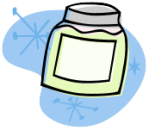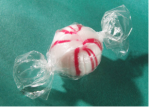 A few weeks ago, I talked about a ‘clinical case study’ posted on a medical supply manufacturer’s website, apparently demonstrating the benefits of using hydrogel dressings when breastfeeding. Unfortunately, the study was poorly designed, and therefore unable to provide support for its considerable claims. It showed, at best, that the dressings did not appear to cause any major problems for a small group of women.
A few weeks ago, I talked about a ‘clinical case study’ posted on a medical supply manufacturer’s website, apparently demonstrating the benefits of using hydrogel dressings when breastfeeding. Unfortunately, the study was poorly designed, and therefore unable to provide support for its considerable claims. It showed, at best, that the dressings did not appear to cause any major problems for a small group of women.
Since then, the dressings have been tested in a larger, controlled study, published in the British Journal of Midwifery1. The article, which describes the dressings as ‘designed to physically protect wounds while maintaining a moist environment,’ concludes that, ‘the dressings can reduce the pain and discomfort associated with nipple excoriation.’ This rhetoric sounds pretty impressive – but does it accurately reflect the strength of the evidence?
On the surface, the study appears to be well designed and reported: 64 mothers were randomly assigned to either the experimental group (wearing dressings between feeds) or the control group (rubbing breast milk on the nipple after a feed), and self-reported pain scores were recorded in interviews 5 times over 14 days. If you read the article carefully, however, a number of inconsistencies become apparent. The abstract and ‘study objectives’ sections say that the aim of the study was to compare the dressings with ‘breastmilk expression and patient education (control group).’ We learn later that in fact both groups received education. The study hypothesis was that, ‘the dressings may reduce nipple pain and excoriation.’ While excoriation (skin wounding/abrasion) is mentioned several times, it was never actually measured – or if it was, the results are not reported.
That the dressings resulted in ‘a considerable reduction in pain’ is highlighted in a special ‘key points’ box. In fact, pain was significantly lower in the dressings group on only one occasion – day 12. The results section states that the average score for the dressings group on this day was 1.3, compared to 2.0 in the control group, and refers you to a graph showing how the scores declined over time. Confusingly, this graph shows the control group score on day 12 not as 2.0, but as 1.4. Clearly, one set of figures is wrong. Given the gradual downward trend of both sets of scores, it would be pretty odd if a pain score went from 1.4 two days previously, to 2.0 (the highest score, recorded at the start of the study), and back down to 1.4 two days later. It seems more plausible that the figures are misreported in the text, and that the statistical tests were in fact conducted with errroneous data. ‘Comfort scores’ are also reported to be consistently lower in the dressings group, although it is not completely clear what these are. They are not mentioned in the method section, and are described in the results section as ‘acceptance of the treatment’ measured using the 1-5 verbal descriptor pain scale. This is the same scale used to measure the other pain score, and how the two actually differ is not explained. Again, the graph and text do not match. The text says that comfort was recorded on days 3, 5, 10 and 12, but the graph also shows data for this measure on days 7 and 14. Interestingly, days 3, 5, 10 and 12 result in comfort scores of 1.0 for the dressings, whilst 7 and 14 show the scores as 1.2 and 1.4 respectively – is it possible these higher scores were conveniently excluded from the analysis?
There are other examples of sloppiness that call into question the integrity of the research. In the introduction, a paper is cited as saying that nipple pain typically starts to decline by day 12. In fact, the study reported in this paper only lasted 7 days2 (this same error occurs in the ‘clinical case study’ reported on the manufacturers website – one can only assume the authors copied the reference without actually bothering to check it). We are told 11 participants dropped out of the study, but not which group they belonged to (they could all potentially have been using the dressings). It is also not clear why 30 people were ‘randomized’ to the dressings group, and 34 to the control group. Why not have 32 in each? A presentation at the International Lactation Consultants’ Association (ILCA) Conference describing the study in progress stated there were 30 women in each group3; why the control group then increases by 4 (unbalancing the design) is a mystery. This presentation also said that breastfeeding duration was being analyzed. Why is this data not provided?
Given that these less than convincing results are reported with great enthusiasm, you would be forgiven for thinking that this might simply have been a promotional exercise. And that, of course, is precisely what it is. Although it is described as ‘sponsored’ research, and discretely labeled as a ‘product focus’, it is not a study that would ever have been published with a negative result.
If you ignore the problems with the figures, and simply take the data at face value, it is possible that the dressings may have provided increased ‘comfort’ for some women. The difference between the scores of the two groups is less than a point, however, and could conceivably be down to experimenter bias, as the investigators conducting the study may have been keen to obtain a positive outcome for their sponsor. Even if the effect is genuine, it certainly does not translate into the substantial support for the dressings claimed in the article. The dressings are marketed as having moist wound healing properties, and although these are alluded to frequently, they are never actually tested. Previous research has shown that hydrogel dressings do not help nipple wounds to heal more quickly when women are breastfeeding, and may potentially foster infection4. When you consider it in this context, what initially appears to be genuinely useful research, may in fact be harmful propaganda.
 Maintaining a slightly damp, rather than dry, environment under a dressing has been shown in many studies to help wounds heal faster. Moisture prevents a scab from forming, which allows new
Maintaining a slightly damp, rather than dry, environment under a dressing has been shown in many studies to help wounds heal faster. Moisture prevents a scab from forming, which allows new  There are many substances said to prevent or relieve nipple pain and damage during the early days of breastfeeding, including
There are many substances said to prevent or relieve nipple pain and damage during the early days of breastfeeding, including  When I suffered substantial nipple damage in the early weeks of breastfeeding, the ‘moist wound healing’ route didn’t prove effective (see
When I suffered substantial nipple damage in the early weeks of breastfeeding, the ‘moist wound healing’ route didn’t prove effective (see  In addition to using a nipple shield, both the health visitor and the NCT helpline lady suggested I try expressing milk and feeding it from a bottle, to give my nipples a bit of a rest. C’s response to the shield was not encouraging, so using a breast pump was really the only option I had left if I wanted to carry on. So far I’d just about been able to put up with the pain: if I gritted my teeth through the initial agony, the remainder of the feed was just about bearable. The sight of my nipples, however, was really quite perturbing. The open wound on the outside edge of one was so deep it looked as if the nipple were in danger of detaching. The psychological effects of seeing this type of damage were considerably worse than the pain. I could only assume it was getting worse with each feed, and therefore that I was mutilating myself further.
In addition to using a nipple shield, both the health visitor and the NCT helpline lady suggested I try expressing milk and feeding it from a bottle, to give my nipples a bit of a rest. C’s response to the shield was not encouraging, so using a breast pump was really the only option I had left if I wanted to carry on. So far I’d just about been able to put up with the pain: if I gritted my teeth through the initial agony, the remainder of the feed was just about bearable. The sight of my nipples, however, was really quite perturbing. The open wound on the outside edge of one was so deep it looked as if the nipple were in danger of detaching. The psychological effects of seeing this type of damage were considerably worse than the pain. I could only assume it was getting worse with each feed, and therefore that I was mutilating myself further.